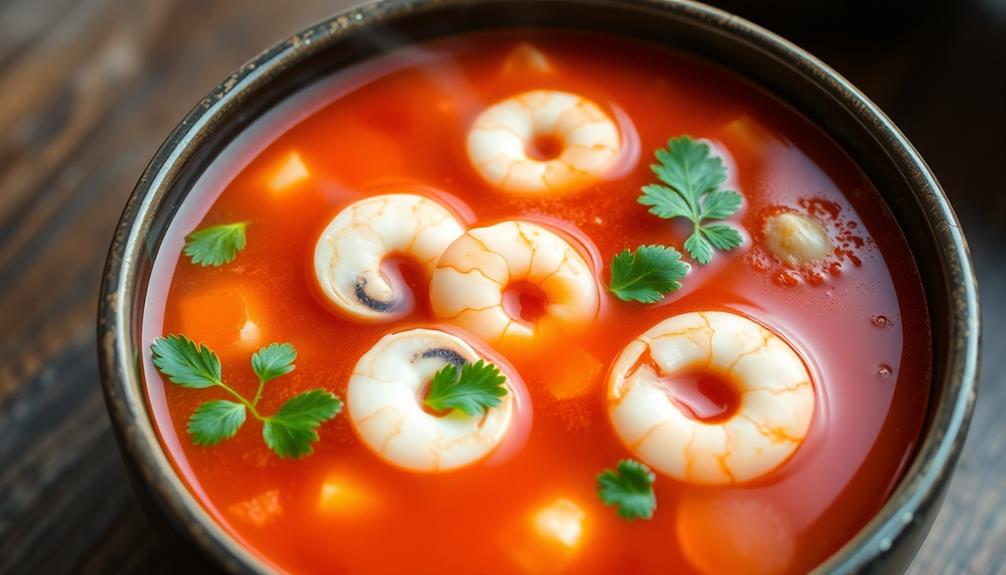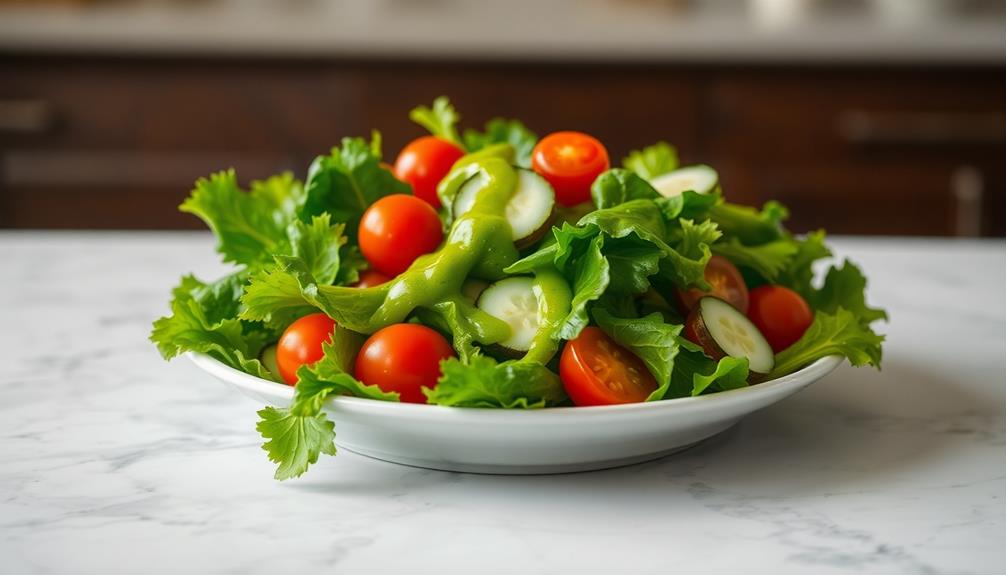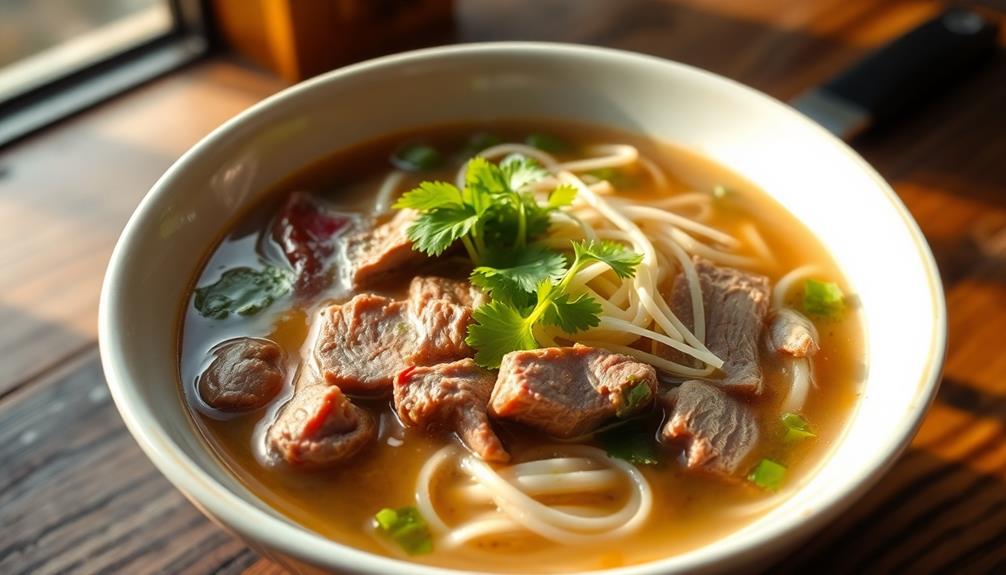Tom Yum, Thailand's iconic hot and sour soup, is a captivating blend of flavors that'll whisk you away to the vibrant streets of Southeast Asia. Originating from Thailand's vibrant street-food culture, this beloved dish showcases the country's culinary prowess, seamlessly weaving together a symphony of sour, spicy, and aromatic notes. Whether it's the Phuket-style creamier broth or the Chiang Mai version with its intense lemongrass flavor, each spoonful of Tom Yum is a delightful journey through Thailand's rich culinary heritage. Dive deeper and you'll discover the art of balancing the flavors and the health benefits hidden within this soup sensation.
Key Takeaways
- Tom Yum is a traditional Thai soup that originated from the country's vibrant street-food culture, representing a blend of sour, spicy, and aromatic flavors.
- The soup's key ingredients include a broth base, shrimp, lemongrass, kaffir lime leaves, galangal, and fresh herbs, each contributing to its complex flavor profile.
- Tom Yum is a cornerstone of Thai cuisine, popular among locals and tourists, and is often enjoyed as a communal dish that symbolizes the rich culinary heritage of Thailand.
- The soup's preparation involves techniques like infusing herbs to create depth in the broth and balancing the flavors to preserve authenticity.
- Mastering the art of Tom Yum reflects culinary skill development and provides an opportunity to explore Thai culture through the enjoyment of this iconic dish.
History
The origins of tom yum soup can be traced back to the vibrant street-food culture of Thailand. This iconic dish has been a beloved staple in Thai cuisine for generations. Its popularity stems from the perfect blend of sour, spicy, and aromatic flavors that tantalize the taste buds. The name "tom yum" refers to the boiling (tom) and pungent (yum) qualities of the soup.
Historically, tom yum evolved from the traditional Thai noodle soups, with the addition of herbs, spices, and seafood. Over time, variations emerged, each region adding its own unique twist. The Phuket-style tom yum, for instance, features a richer, creamier broth, while the Chiang Mai version showcases a more intense lemongrass flavor.
This adaptability has allowed tom yum to become a beloved dish across Thailand and beyond.
Today, tom yum remains a cornerstone of Thai cuisine, enjoyed by locals and tourists alike. Its vibrant colors, aromatic steam, and bold flavors have made it a true culinary icon, representing the rich heritage and dynamic flavors of Thailand.
Recipe
Tom Yum Soup is a popular Thai hot and sour soup that's bursting with flavors. This dish is known for its lemongrass, kaffir lime leaves, and galangal, which provide a complex and aromatic base. The addition of shrimp, mushrooms, and fresh herbs creates a well-balanced and satisfying soup. When enjoying Tom Yum Soup, the tangy and spicy flavors of the Thai hot and sour shrimp soup make it a must-try for anyone visiting Thailand or exploring Thai cuisine. The dish is often served as an appetizer or as a main course, and is a favorite for those looking for a flavorful and comforting meal. Whether you’re a fan of seafood or simply enjoy bold flavors, Tom Yum Soup is sure to delight your taste buds.
Preparing Tom Yum Soup at home is a straightforward process that can be customized to your taste preferences. Whether you prefer a spicier or milder version, this recipe will guide you through the steps to create an authentic and delicious Tom Yum Soup.
Ingredients:
- 4 cups chicken or vegetable broth
- 2 lemongrass stalks, bruised
- 3 kaffir lime leaves
- 2-inch piece of galangal, sliced
- 2 tablespoons fish sauce
- 2 tablespoons lime juice
- 1 teaspoon chili-garlic sauce (or to taste)
- 10 oz medium shrimp, peeled and deveined
- 4 oz oyster mushrooms, sliced
- 2 green onions, sliced
- 1/4 cup fresh cilantro, chopped
- 1 Thai bird chili, sliced (optional)
Instructions:
In a large saucepan, combine the broth, lemongrass, lime leaves, and galangal. Bring to a boil over high heat, then reduce the heat and simmer for 10 minutes to allow the flavors to infuse.
Stir in the fish sauce, lime juice, and chili-garlic sauce. Add the shrimp and mushrooms, and cook for 3-5 minutes, or until the shrimp are opaque.
Remove the lemongrass, lime leaves, and galangal. Garnish the soup with green onions, cilantro, and sliced Thai chili (if using).
When preparing Tom Yum Soup, be sure to use high-quality, fresh ingredients for the best flavor. If you prefer a less spicy soup, start with a smaller amount of chili-garlic sauce and adjust to your taste.
Additionally, you can experiment with different types of mushrooms or proteins to personalize the dish to your liking.
Cooking Steps
Get ready to dive into the flavorful steps of making Tom Yum Soup! First, prepare the aromatic ingredients like lemongrass, galangal, and kaffir lime leaves.
Next, add the shrimp and fish sauce to create a savory base.
Then, finish off with a splash of lime juice and seasonings to balance the flavors.
Don't forget to toss in some mushrooms and fresh herbs for the ultimate Tom Yum experience!
Step 1. Prepare the Aromatic Ingredients
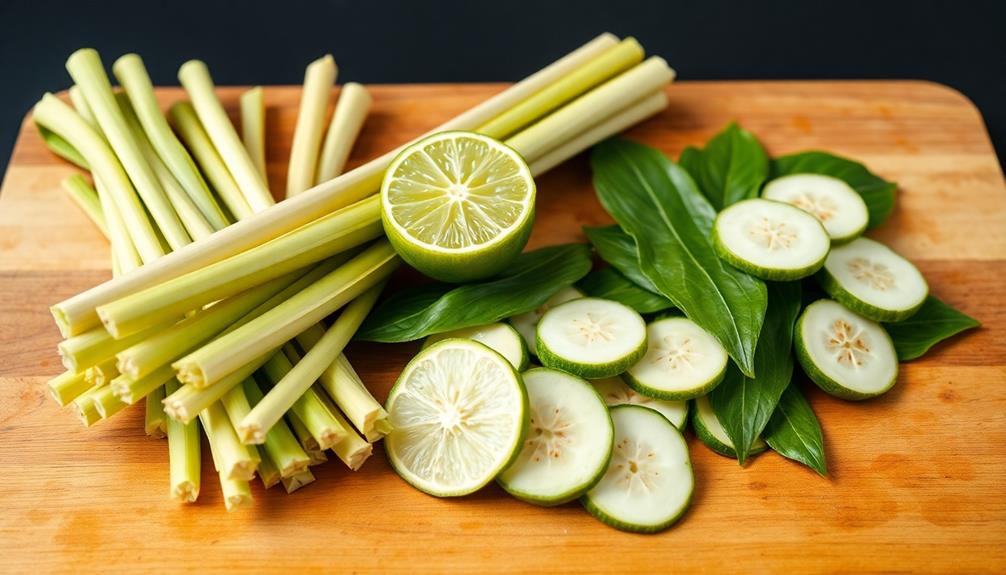
To prepare the aromatic ingredients, start by peeling and thinly slicing the shallots. You'll want about 2 tablespoons of sliced shallots.
Next, peel and thinly slice the fresh lemongrass. You'll need about 2 tablespoons of lemongrass slices.
Crush the lemongrass with the flat side of a knife to release its fragrant oils.
Then, thinly slice the galangal. You'll need roughly 1 tablespoon of sliced galangal. Galangal is a root similar to ginger, but with a more woodsy and citrusy flavor.
Step 2. Add Shrimp and Fish Sauce
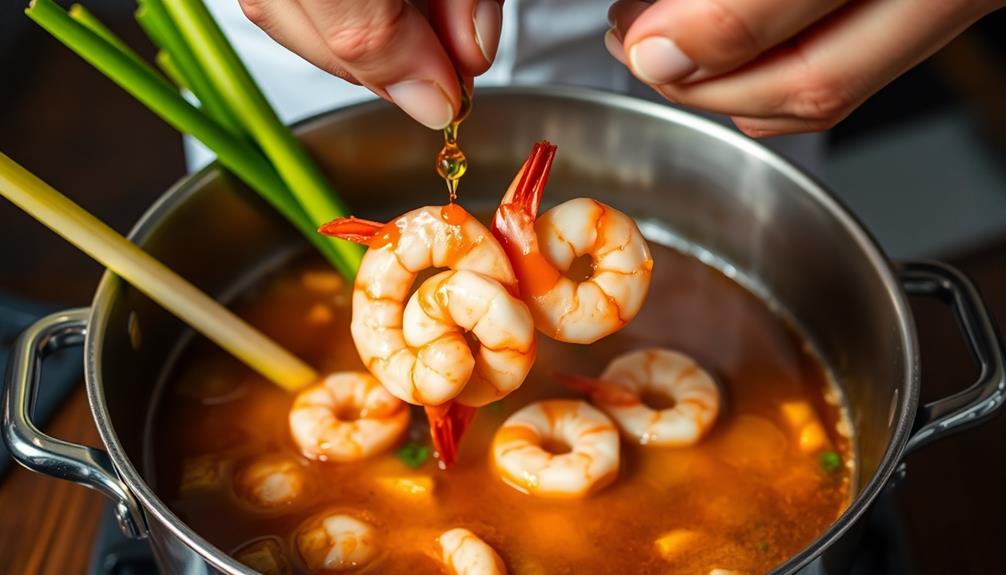
With the aromatic ingredients prepared, you can now add the shrimp and fish sauce.
First, toss the shrimp into the pot. These juicy crustaceans will soak up all the wonderful flavors, making every bite irresistible.
Next, drizzle in the fish sauce. This umami-packed condiment will enhance the overall taste, balancing the sour and spicy notes.
As the shrimp cook, they'll turn pink and curl up. This is a sign they're ready! Give the pot a gentle stir to ensure the shrimp are evenly cooked. The fish sauce will blend seamlessly, adding depth and complexity to the broth.
Now, take a moment to inhale the captivating aroma. The fragrance of lemongrass, kaffir lime, and galangal will transport you straight to the bustling streets of Thailand.
Get ready for a flavor explosion that's both invigorating and comforting. With the shrimp and fish sauce added, your Tom Yum soup is well on its way to perfection.
Step 3. Add Lime Juice and Seasonings
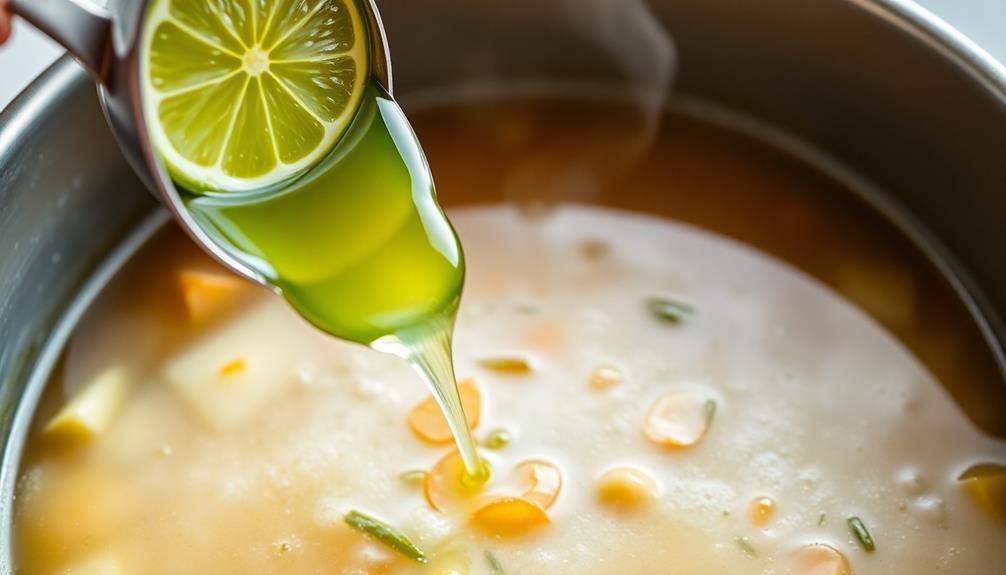
Now that the shrimp and fish sauce have been incorporated, it's time to add the final touches to your Tom Yum soup.
Grab a fresh lime and give it a good roll on the counter to release its juices. Slice it in half and squeeze the bright, tangy juice into the pot. The lime's acidity will brighten up the flavors and balance the heat.
Next, sprinkle in a pinch or two of white sugar. This small amount of sweetness will counteract the sour and spicy elements, creating an irresistible harmony of tastes.
Don't forget to season with a dash of salt, too. Taste the soup and adjust the seasonings as needed until it's perfectly seasoned to your liking.
Step 4. Add Mushrooms
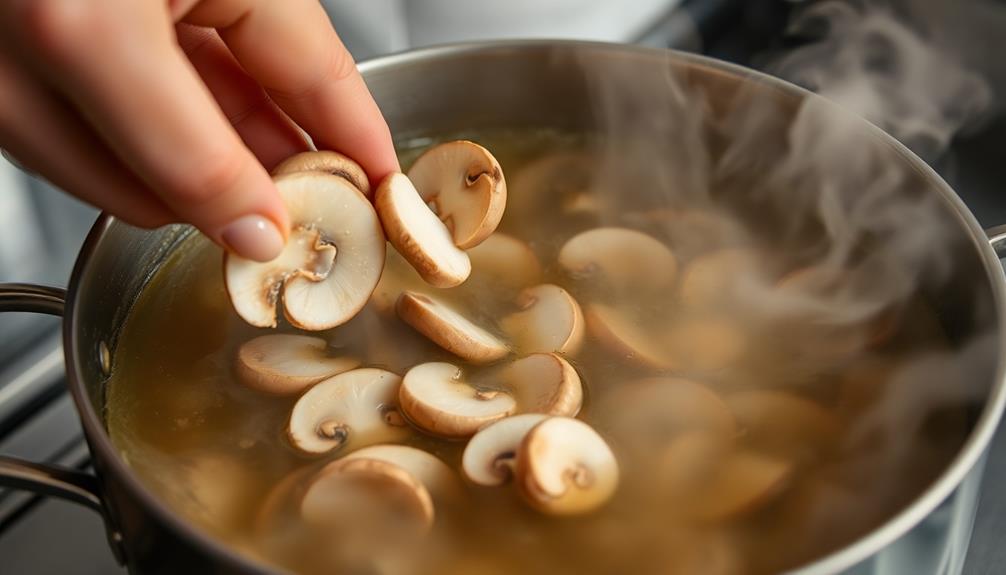
Add the mushrooms to the flavorful broth. They'll soak up all those amazing flavors! Slice them nice and thin so they cook quickly. You can use any type of mushrooms you like – white, cremini, or even exotic ones like shiitake.
As the mushrooms simmer, they'll become tender and release their earthy aroma. Give the pot a gentle stir to make sure the mushrooms are evenly distributed. They'll turn a lovely golden brown color as they cook.
Now, let's add a few more key ingredients to really make this soup shine. A sprinkle of fish sauce will introduce a salty, umami punch. And a squeeze of fresh lime juice will brighten up the whole dish with its tangy zing.
The mushrooms, fish sauce, and lime juice all work together to create the perfect balance of flavors in this Thai classic. Get ready for an explosion of taste in every spoonful!
Step 5. Add Fresh Herbs
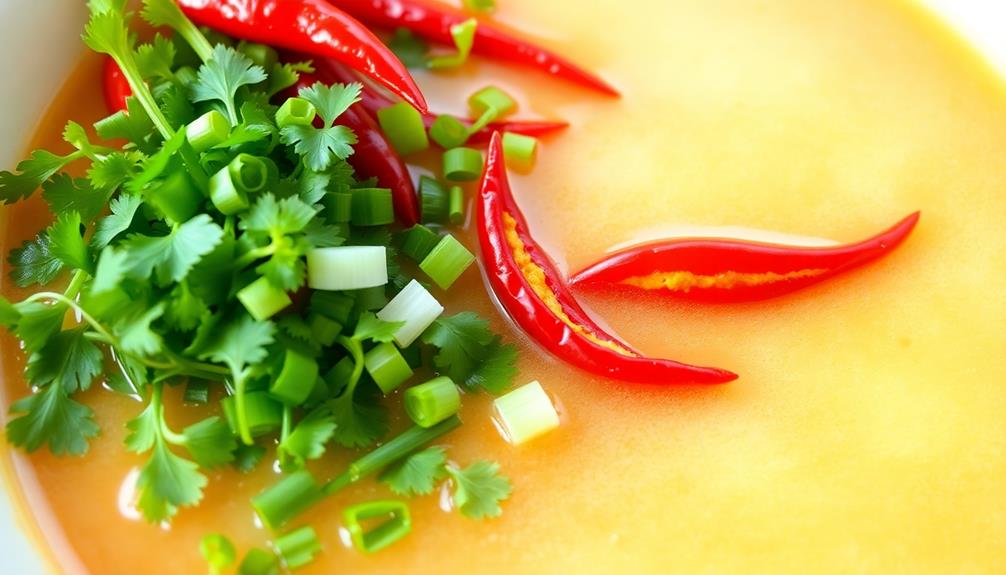
Tossing in a handful of fresh herbs elevates the aromatic profile of the Tom Yum soup. These vibrant ingredients add a burst of flavor and complexity to the dish. Reach for fresh lemongrass, kaffir lime leaves, and cilantro to heighten the citrusy notes. The lemongrass lends a pleasant lemony aroma, while the lime leaves impart a fragrant, slightly bitter undertone.
Additionally, incorporating essential oils like eucalyptus oil can enhance respiratory health, which is helpful when enjoying spicy dishes. Sprinkle in chopped cilantro at the end for a fresh, herbal finish.
These aromatic herbs not only taste delicious, but they also provide numerous health benefits. Lemongrass is known for its anti-inflammatory properties, while kaffir lime leaves are packed with antioxidants. Cilantro, with its vibrant green color, is a rich source of vitamins and minerals.
Together, these herbs create a symphony of flavors that dance across your taste buds, elevating the Tom Yum soup to new heights of complexity and depth.
Final Thoughts
Have you thoroughly enjoyed the wondrous journey of preparing Tom Yum Soup? If so, you should feel proud of your accomplishments. Creating this iconic Thai dish from scratch is no easy feat, but you've managed it with flying colors.
Now that you've added the fresh herbs, your Tom Yum Soup is complete and ready to be savored. The vibrant flavors of lemongrass, kaffir lime leaves, and galangal have infused the broth, creating a harmonious balance of spicy, sour, and aromatic notes.
The tender shrimp and crunchy vegetables provide a delightful contrast in textures.
As you sit down to enjoy your homemade Tom Yum Soup, take a moment to appreciate the culinary skills you've developed. This dish is a testament to your dedication and willingness to try new things.
Savor each spoonful, allowing the flavors to dance on your palate. Relish in the knowledge that you've mastered the art of creating this Thai classic.
Frequently Asked Questions
What Are the Health Benefits of Tom Yum Soup?
Tom Yum soup offers numerous health benefits. It's packed with antioxidants, boosts your immune system, aids digestion, and can even help reduce inflammation. Plus, its tangy, spicy flavors make it a delicious and healthy choice for mealtime.
How Can I Adjust the Spiciness Level of Tom Yum?
To adjust the spiciness level of tom yum, you can start by adding fewer chili peppers or using milder varieties. You can also balance the heat with more lime juice, fish sauce, or sugar to suit your preference.
Is Tom Yum Soup Suitable for Vegetarians or Vegans?
Yes, tom yum soup can be suitable for vegetarians or vegans. You can omit the shrimp and use vegetable broth instead of chicken or fish stock to make it meat-free. Many ingredients in tom yum are naturally plant-based.
Can I Make Tom Yum Soup With Different Types of Seafood?
Yes, you can absolutely make tom yum soup with different types of seafood. Try shrimp, squid, or fish – they'll all work great and add their own unique flavors to this Thai classic.
How Long Does Tom Yum Soup Keep in the Refrigerator?
Tom Yum soup can typically be stored in the refrigerator for 3-4 days. However, it's best to consume it within 2-3 days for the freshest flavors. Be sure to store it in an airtight container to maintain its quality.
